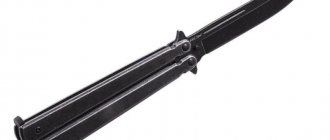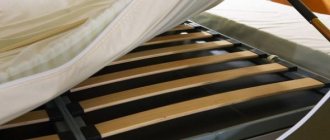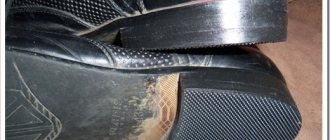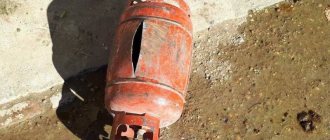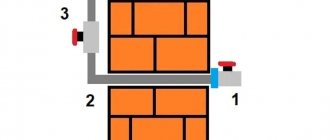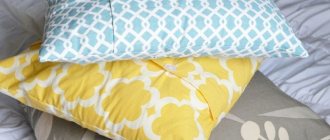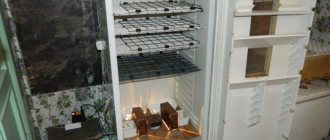Hi all! Today I would like to talk about such a topic as ironing board repair. Good boards don’t cost that little and can last for many years.
But most often, our compatriots save money, take cheap Chinese products, which are cheap, but sometimes last literally 1-2 years even when used with an average degree of efficiency.
If we talk about typical breakdowns, then most often we are talking about a failed lifting mechanism, when the structure is not fixed in a given position. It is also necessary to repair the legs, replace the gasket and reupholster the surface with new fabric.
How to sew a cover for an ironing board with your own hands: updating old fabric
Sewing a cover for an ironing board is easy, the main thing is to know how to do it correctly and have a sewing machine. The need to replace the cover may arise if the old cover has worn out, lost its attractive appearance, or was accidentally burned through by a hot iron. During use, the old fabric gradually becomes clogged with dust, and after 10-15 years, when using a dirty board, you may encounter the problem of stains appearing on clean white linen.
Of course, you can purchase a ready-made, new case in the store. But, if you need to replace the fabric on an old-style ironing board that has long been discontinued, it may not fit. In addition, when buying a finished product, you may not be able to guess the dimensions even for a modern board. As a result, the cover will dangle, form wrinkles and complicate the ironing process.
Rules for choosing fabric for a cover
Cotton calico is considered the ideal option for upholstering an ironing board, although other types of fabrics can be used if desired. The main thing is that the material does not stretch. Otherwise, the new case will quickly become deformed.
When choosing fabric, you should also consider the following recommendations:
- The material must be resistant to shedding. When ironing using the steam mode, light-colored items may become dirty from the shedding cover and become unusable. To check whether the material is subject to shedding, you will need to wash it in a basin of warm, clean water. If the water remains clean after washing, then the fabric is suitable for sewing a cover, and vice versa.
- A cover that is too light in color will quickly become dirty and covered with yellow spots from the hot iron. Therefore, it is better to opt for darker colors. If you still like light-colored materials, then you can sew several removable covers and replace them periodically.
- The fabric used to cover the ironing board should not contain additives that will stick to the iron when it heats up. Firstly, you will have to constantly clean the soleplate of the iron so that it glides well on things. And secondly, a dirty sole can easily stain the item you are ironing.
We recommend: Bad advice that our grandmothers gave us. Why is it better not to do this?
Removable cover
First you will need to remove worn out, old fabric from the ironing board. This procedure is performed using pliers. Using the sharp end of the tool, pry the bracket, clamp it and carefully pull it out. Thus, it is necessary to remove all the staples that secure the covering to the tabletop.
Next, you need to remove the top fabric and inspect the backing. If it is in good condition, then the material is carefully washed in warm soapy water, dried and ironed with a lot of steam.
Now we proceed directly to cutting and sewing the cover itself. The procedure is performed in the following order:
If a cord is used instead of an elastic band, its ends are fixed with a special stopper. It can be purchased at any sewing supply store. This limiter is very convenient to use, as it is equipped with a locking button that allows you to tighten the cord as tightly as possible.
The cover for the ironing board is ready. All that remains is to put it on the countertop and start ironing the laundry.
Case secured with staples
The material fixed with a stapler will hold much more firmly and fit very tightly to the base. But, if there is a need to wash it, you will have to spend time and effort removing each staple.
If you do not want to make a cover with an elastic band or tape, you can attach it to the board using staples. In this case, a furniture stapler is used, and instead of tape, you will need to prepare a long strip of adhesive non-woven fabric 5 cm wide.
The edges of the main part are folded in by 5 cm and a strip of non-woven fabric is inserted into the resulting fold. Then heat the iron and iron the fabric so that the interlining sticks well to the material. The result should be a part with compacted edges that will ensure the strongest possible fixation of the staples.
Now you need to properly attach the cover to the tabletop.
There is no need to over-tighten the material. As a result, the front side should be perfectly smooth without distortions or folds.
This method can only be used to update pressed wood ironing boards. For metal structures, an option with a cord or elastic band is suitable.
Source
Sewing a new cover
We draw a line to make a so-called channel for an elastic band or thread.
We install the ironing board so that the gasket is on top, and install the new cover on top as well. Fold the edges by about 0.5 centimeters and press well with an iron.
The channel doesn't have to be perfect, just do it by eye.
Now fold the edges again by about 0.7 centimeters.
“Hands froze”: Russian woman played in a landfill at -30 for the sake of clean ecology
It became known how many Russians are ready to give up plastic tableware
“Believe and know your worth”: Anna Khilkevich about real men
This can be a little tricky if you've never done this before because the corners are uneven. Try approaching the corners from different angles if you can't get them right the first time. Just make sure you don't fold the material too much or it will make it difficult for the thread or elastic to pass through the body.
I did this job a little sloppily, but I tried.
Take two pins and place them a few centimeters apart in the center of the back of the lid.
We use an allowance of 0.2 centimeters. Starting from one edge, sew everything in a circle.
When it comes to folds, your sewing machine may catch on them. In this case, stop the machine with the needle pointing down and raise the presser foot. Slide the pleated fabric back under the presser foot and continue sewing.
Move to the other marked edge of the body. Remember to backstitch at the beginning and end.
How to sew a cover for an ironing board. Which fabric to choose?
How to sew a cover for an ironing board. Which fabric to choose?
An ironing board is a very important and necessary thing. It’s probably rare that a housewife doesn’t have such an assistant in her everyday life.
How else can you iron your laundry?
She always comes to the rescue and serves faithfully!
But, as you know, nothing is eternal. And this is the absolute truth. If iron can still withstand n number of years, then the fabric on the ironing board will become unusable quite quickly.
And what to do with this torn and frayed rag? Change!
So, a story about how to replace fabric and sew a new ironing board cover.
First, an introductory lecture on what materials we will need. You need to purchase fabric, tape and foam.
First things first.
The best fabric to choose for your ironing board is:
In terms of color - light colors, in order to avoid painting over things that will be ironed. In terms of density, the fabric should not be loose, i.e. chintz will not work; it is better to choose either dense calico or teak. In terms of composition, the fabric should be cotton.
Both regular tape (braid, lace) and an elastic band can be used as a ribbon for the ironing board.
1. This is what the ironing board looked like after using it for several years (very often) and before I sewed a cover for it.
2. Remove the old cover and cut a new one over it.
!ADVICE! It is better to cut a new ironing board cover a little larger than the old one. This increase will be a reserve for shrinkage, because Cotton fabrics give good shrinkage.
We process the edges of the cut cover with a hem seam with a closed cut. We sew the hem, leaving a small hole through which we thread the lace.
3. From padding polyester, cut out a piece in the shape of the upper part of the ironing board, and place it on top.
4. We put a cover over the padding polyester, pull it tightly, and tighten the lace under the board, the ends of which we tie with a bow or a knot. The new ironing board cover is ready.
This article will be useful for those who already have an ironing board. But to those who are just planning to purchase it, I would like to suggest that they think about it and not rush to buy an ordinary traditional board. You can purchase a modern ironing system that will allow you to iron your laundry quickly and efficiently, with a minimum of effort. What was once a dream, namely an ironing board with a steam generator, has now become a completely affordable reality. It not only irons and smoothes out wrinkles on clothes, but can effectively care for dusty furniture and can easily cope with lambrequins and carpets. Give yourself a gift!
Source
Choosing a mount
There are two ways to attach (put on) the cover to the ironing board:
Most cases are made with an elastic band, but if you really want, you can also find them with a cord. Covers with elastic fastening are very convenient to use, as they simply stretch and attach to the edges of the ironing board. However, this mount will not work if your board has an attached iron stand. If the stand is detachable, it can also be used with an elastic band.
There will be no such problems with lacing; it will fit in any case. Allows you to adjust the tension of the cover.
Popular types of cases
Currently, there is a wide range of ironing board covers on the product market. When choosing, you need to pay attention to such characteristics as size, functionality, material, price and color.
The quality of the case and its functionality directly affect its price. Budget options are made from simple cotton fabric, usually not intended for high temperatures. Fabric that does not allow moisture to pass through and does not stick to the iron will cost more.
Table: comparative characteristics of covers
| Type of cover | Material | Functional | Example | Price |
| Universal | Cotton or calico | For different sizes of ironing boards | Nika Ch2, 129x51 cm | 250 rub. |
| Cotton | Cotton or linen | Unpretentious to use, long service life without loss of appearance, anti-allergenic | DOGRULAR 54004, 130x46 cm | 299 rub. |
| Teflon coated | Special coating - Teflon | Easy ironing, ironing effect on both sides due to the heating of the cover, things do not burn or stick | Eva, 120x40 cm | 350 rub. |
| With foam rubber | Foam backing, top fabric can be any | Provides soft ironing and eliminates dents from the board | Nika ChP3, 125x45 cm | 350 rub. |
| Non-stick coating | Fabric impregnated with silicone | Easy ironing, double-sided ironing, the surface of the iron does not burn, does not leave yellow marks on clothes | Nika ChPA3 NON-STICK, 129x53 cm | 440 rub. |
| Metallized | Contains metal thread | Easy, high-quality and fast ironing due to heat transfer from the metal, double-sided ironing effect | Leifheit Reflecta Speed Universal, 140x45 cm | 1000 rub. |
| With elastic band | Cotton or calico | Easy to attach to the board using a built-in elastic band | Eva, 119x37 cm | 200 rub. |
The variety of models allows you to choose a case for every taste and budget.
Materials for work
So, we have decided on the fabric for the top layer and backing, and now we need to prepare for the process of making the cover. To work you will need:
- Scissors.
- Long ruler or tailor's centimeter.
- A piece of sharpened chalk or soap, or a tailor's pencil specially designed for marking.
- Sewing machine.
- Tailor's pin.
- Threads in the color of the selected material.
- Elastic band or long braid.
- Small round nose pliers.
Replacing the old cover
The removable cover can always be washed if it gets dirty. However, the fabric gradually becomes unusable, so from time to time the coating requires replacement. There are several ways to apply a new cover to your ironing board.
How to secure
You can sew it yourself by sewing elastic around the edge. If the board is metal or has a mesh surface, you can choose another method. You can insert a rope into the fold of the cover, with which you can tighten the cover on the board.
If the ironing board top is made of wood, it is simply wrapped in fabric, which is secured with furniture clips. This is, of course, the old way of putting a cover on a board, but the cheapest.
Should I remove the old coating?
If the fabric is snow-white, then it is advisable to remove the old coating, as well as its gasket, to avoid contamination on the new cover. If you use colored fabric, this is not necessary. You will only need 0.6 meters of light fabric (cotton, calico) and light batting, their width should be 150 centimeters. Light shades are preferable to bright ones because they will not fade or ruin white items. Instead of a stapler, you can use nails that you can simply bend.
Preparation stage
Remove the lid and set it aside. Place the pad on the floor and the ironing board on top of it. We lay the lining in two layers. Take a marker and trace the edge of the ironing board.
If you decide to make the lining with only one layer of material, simply cut along the line. If you are making multiple layers, staple the layers together and trim them outside the lines. We'll need to stitch it all together later.
The print will make your figure perfect: classic dresses of the year for women over 45
Lemon water: the right drinks to start your day with
“Rose gold” will add zest to your look: fashionable coloring ideas
How to change the upholstery on an ironing board?
For a wooden ironing board, it is not necessary to sew a cover; you can simply cover the surface with fabric and secure it with a stapler. This option is suitable for those who do not have a sewing machine.
For new upholstery of a standard board, it is enough to purchase 0.8 m of thin fabric and the same amount of batting. The minimum width of the canvas is 150 cm. The most convenient way to secure the upholstery is with a furniture stapler, but if you can’t get one, small post nails will do just fine. They do not need to be hammered in completely; the ends can simply be bent.
To cover a board, you first need to remove the old upholstery (along with the lining) from it. This is done so that, under the influence of moisture, the old cover does not stain the new fabric, especially if it is light.
Read how effective Calgon powder is for washing machines and what cheap analogs exist.
We recommend that you find out what products available in the household can be used to clean mirrors.
How to stretch fabric?
The upholstery should fit perfectly to the tabletop. To do this, you should tighten it in a certain way:
Fabric stretched in this way will not have folds or skewed areas. You don't need to pull it too hard. It is enough that the surface is smooth.
Important: before you start reupholstering, it is advisable to wash the material at high temperature, since cotton fabrics shrink.
Types of board covers
There is a wide range of coatings. They differ in shape, size, models, materials. The main varieties are represented by a number of models.
- Polyester. This is the cheapest type of cover. What can attract attention in such a case is only its appearance, and unfortunately, there is nothing special or remarkable. Their service life is maximum 2 years.
- 100% cotton. Popular and most profitable option. Such products are easy to wash, do not fade during use, and have a fairly long service life - about 3 years. Their disadvantage is that they are not heat-resistant; if you leave the iron turned on in a horizontal position, the cover will burn out.
- Teflon. Thanks to this innovation, our items will not stick during ironing. Their surface is resistant to high temperatures. The cost is higher than cotton.
- Foam rubber. We provide soft ironing. Resistant to all temperature conditions.
- Universal. Ideal option, suitable for most ironing boards. The dimensions of such cases are 129 x 51 centimeters. It has bright and different colors. There are no problems with it during washing. The price is moderate and pleasant.
- With non-stick coating. The fabric from which the case is impregnated with silicone during the manufacturing process. This makes the cape resistant to even the highest temperatures. Clothes don't stick. This case will last for a very long time.
- Metallized. When sewing, a special thread is used, which makes this case very high quality. These products are the most durable. The aluminum thread guarantees heat transfer and that is why ironing occurs simultaneously on both sides.
- Cover with elastic band. Very convenient to use. Easy to take off, put on, and fix. If necessary, you can quickly remove and wash. The downside is that it is not suitable for boards with an iron stand. And the elastic band becomes deformed over time, stretches, and you have to buy a new cover.
- Miracle case. This invention appeared and entered the market in 2010. It surpassed its predecessors in its properties. Heat resistance, long service life, water resistance – these are the main characteristics of the miracle case. With its use, the time spent on ironing is reduced, and the quality, on the contrary, is higher. The maximum temperature it can withstand is 150 degrees. New technologies and materials were used for its production. The quality of this product was checked by tests, and it is worth noting that it coped with all of them.
This thermal cover does not require special washing or cleaning - in case of contamination, the stain is removed with a regular sponge.
Making a cover for an ironing board with your own hands
It is advisable to replace the cover approximately every 2 years. And sometimes you don’t want to spend money on expensive options. A homemade case is a good alternative.
Choosing the right fabric
When selecting material, you must be guided by the following characteristics:
It is better to opt for a cotton or linen option (thick calico, flannel or teak are an excellent choice in this case). It is not advisable to choose chintz, as the fabric is loose. It is advisable to choose a light and monochromatic color of the canvas. But, if the choice fell on colored fabric, then it is better to test it for possible dyeing.
It is also necessary to make a lining, for which foam rubber, batting, felt or padding polyester are usually suitable. Foam rubber wears out faster when heated and in the presence of moisture, batting or felt is more durable and does not cause the cover to fidget on the board due to its rough structure.
Felt is a better choice for the substrate than foam rubber
Sewing and inserting elastic
In the case of a wooden board, it is not necessary to engage in labor-intensive sewing of the cover. It is enough to cover the surface with new fabric and secure it with a stapler.
However, many modern ironing boards have a mesh surface attached to a metal frame. In this case, the stapler will not work and it becomes necessary to sew a cover.
For the pattern, you will need a piece of the selected fabric measuring 150x60 cm. The outline of the table top of the board is traced on the fabric, 6-7 cm is added on each side for hemming and the excess is cut off. To process the edges, you need to bend the fabric on different sides by 5 mm and iron it, then fold it another 1 cm, baste it and stitch it on a machine.
The pattern of the cover is quite simple, the main thing is not to forget to leave indentations for the hems and insertion of the fastener (elastic band or cord)
There are 2 options for attaching the cover:
There is a simpler option with a double pillowcase-type cover. In this case, the hem for attaching the cover does not need to be hemmed separately. The pattern is formed in the same way, only 2 pieces of fabric are taken and placed “facing” each other. The hem is 10–15 cm, and at the end of the pattern mark the place of turning.
Step back 1 cm from the edge of the workpiece and stitch, except for the hole at the end. Then turn it inside out, iron the cover and sew up the hole for turning it inside out, leaving 2-3 cm for the elastic. To create a drawstring for the elastic, a stitch is made at a distance of 2 cm from the edge. The case is ready.
Stability and supports
When purchasing, pay attention to the width of the legs and the method of fastening. If the legs of the ironing board are not widely spaced, the stability of the product will be poor. The best option is when the base of the legs is wider than the tabletop.
If the legs are attached to the tabletop and to each other using bolts and rivets, they may become loose over time. Rivets are considered the most unreliable method of fixation.
To prevent the board from slipping and scratching the floor, choose products with silicone or rubber caps on the legs.
When purchasing, pay attention to the shape of the legs. T-shaped structures are considered the most stable.
Choosing material for the ironing board
The cover needs to be changed on average every 2 years. What fabric can be used to make a cover for an ironing board? Basic requirements for the material:
Preference should be given to cotton, linen or light blended fabrics. It is not recommended to choose chintz - it is too loose, but dense calico, flannel or teak will work perfectly. It is desirable that the canvas be monochromatic. It is better to check variegated fabric for dyeing in advance.
For lining, white batting, felt, padding polyester or thin foam rubber is usually used. It should be borne in mind that foam rubber is not the most durable material - under the influence of humidity and high temperatures it quickly loses its softness. It is better to choose batting or felt - they are quite rough, which means that when ironing the cover will not slide on the board.
Do I need to change the substrate?
Replacing the lining located between the board itself and the fabric may be necessary in the following cases:
- If it became deformed or torn during the process of removing the old fabric.
- If the insulation is old, dirty and stains the laundry when ironing.
- If during use it has become leaky, resulting in the surface of the board becoming uneven.
To make the lining, any insulating material is suitable - foam rubber, synthetic winterizer or batting. You can also use felt or cut a lining from an old flannelette blanket.
Nominal quality
If your board was manufactured by a company with a name, then the possibilities for purchasing accompanying accessories will be much wider than for owners of nameless ironing boards. Thus, any cover for a Zalger ironing board is developed for a specific model or a number of them, taking into account all the nuances of the design. Also, don’t forget about quality. The coating, lining, processing of all details - everything is at the highest level. A wide range of materials and designs will allow you to choose exactly what you dreamed of. Plain or with patterns, such removable coatings are absolutely not dangerous for white or colored items, since manufacturers use only high-quality dyeing technologies.
A good ironing board cover will serve you for a long time and will not lose its original appearance and qualities.
Source
Additional accessories for ironing
For greater convenience during ironing, the ironing board cover can be slightly “improved”. For example, sew a pocket like this in which you can store an iron cleaner, a sprayer, threads for basting, a pad with needles, etc. But the most convenient and most importantly necessary additional device for an ironing board can be considered various flat pillows. They are very effective for ironing and ironing seam allowances, removing excess moisture from an ironed product, etc. You can make such a pillow from any thin fabric, including synthetic, and put several layers of batting or foam rubber inside. Those who sew with their own hands often require various lasts for ironing sleeves and other hard-to-reach places. You can replace the cover for such a miniature ironing board using the same methods as the cover for the ironing board.
READ How to mount an ironing board on a wall
Tailor's dummies Sewing a cover for an ironing board is a very simple task for an experienced seamstress. It is much more difficult to reupholster a dilapidated old-style mannequin cover. To sew such a cover, you must first make precise patterns using the ripped apart parts of the removed mannequin skin.
How to choose an ironing system The tabletop ironing system has a number of additional functions, not only pumping air using a fan. The cover of such an ironing board can heat up to 90 degrees, which improves the ironing and drying process.
How to choose the right iron When purchasing a new iron, you need to focus not only on its price, but also on the power of the Tubular Heater, the quality of the coating of the iron sole
The weight of the iron, the shape of the handle, the volume of the steam chamber, etc. are of no small importance. How to choose a household iron with a steam generator In the ironing system, the iron must be a steam iron or with a steam generator
How to choose a household iron with a steam generator In the ironing system set, the iron must be steam or with a steam generator. The cost of such a system is quite high, so if you decide to sew a cover for your ironing board, use only high-quality fabrics.
We sew a sheet with an elastic band with our own hands The technology for sewing a sheet with an elastic band is somewhat reminiscent of the technology for sewing a cover for an ironing board. Clasps are often used to tighten the corners of such a sheet; they can also be used to tighten the ironing board cover.
Do-it-yourself fabric reupholstery on an ironing board
Do-it-yourself fabric reupholstery on an ironing board
My ironing board is exactly 10 years old.
My mother gave it to me with the hope that her daughter would become a good wife.
